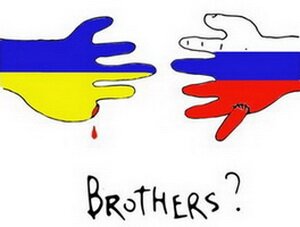
November 29, 1947 the UN General Assembly voted for the creation of two new states — a Jewish and an Arab ones (Resolution №181). The Jewish population was happy about this decision. But the Arab population — was not, as the Jewish country's territory turned out to be significantly larger than the Arab one.
May 14, 1948 the Jewish National Council announced the creation of the State of Israel, and on the night of May 15, Egyptian planes bombed Tel Aviv, and the thirty thousand army of five Arab states began military operations against the newly declared country. That is how the long-term and bloody Middle East conflict began.

|
|
The Middle East conflict http://knowhistory.ru/ |
February 21, 2014 the Maidan won. It was still covered with blood of the “Heavenly Hundred's” heroes, and Ukraine was weak, but hopeful for the future. And already on February 27, in the Crimea “suddenly” appeared “little green men” and began the annexation of the Crimean peninsula, which then developed into a direct aggression of Russia against Ukraine.
March 11 was adopted a declaration of independence of the Autonomous Republic of the Crimea and of the city of Sevastopol. March 16 saw a referendum “quickly” fabricated, and already March 18 was signed an agreement between the Russian Federation and the Republic of the Crimea on the integration of the latter into the Russian Federation.
Between these two events 66 years had fit... The Middle East and Europe — what can there be in common? If you think, there is a lot in common. The long-term war in the Middle East is of certain interest for Ukraine. In particular, the tactics and strategy of Israel in its countering the foreign armed aggression. And especially — the same experience of Syria. The paradox here is that the countries of Israel and Syria, having been for many years in the state of war with each other, to all that are surrounded by countries trying to destroy Israel and Syria's independence.
Let's leave out of sight political and economic aspects and look more attentively at the main differences between the military components of the organized by Israel and Syria countering the foreign aggression.
 The State of Israel:
The State of Israel:
Firstly, it is a relatively small territory, which does not allow the armed forces to carry out large-scale military maneuvers, such as the rapid advance/retreat, throwing of troops over long distances, and the like.
Secondly, a sufficiently high density of the population, almost without exception having the general military training and in a very short period of time is ready for general mobilization — “One nation — one army.”
That is why the leadership of the country carries out an exceptionally aggressive offensive tactics, including in the form of application of “surgical” missile and air strikes on objects situated in the enemy's territory.
 Syrian Arab Republic:
Syrian Arab Republic:
Let's look more closely at the latest period — 2011-2014. Despite the 300-thousand armed forces of the SAR, the general mobilization, formed volunteer battalions and assistance in the form of “Hezbollah” groups and groups of special operations forces “Qods” from the Guardians of the Islamic Revolution of the Islamic Republic of Iran (total of about 400 thousand people), the Syrian leadership due to the large territory (the length of the border with Turkey is 900 km, with Iraq — 600 km, with Jordan — 370 km), could not organize a reliable protection of the external borders and was forced to gradually withdraw troops from the border into the territory. As a consequence, the Syrian government:
- has completely lost control of most of the borders and border areas through which is taking place throwing of equipment and militants from Islamist terrorist organizations. At this, the government of the SAR launches rocket-artillery and air strikes on the enemy and carries out individual ground operations;
- has lost control over a part of agricultural areas and oil and gas fields, which makes it implement large-scale imports of food and fuel;
- has actually lost control over a part of the population living along the border, and partially — over the population of central areas of the country, to some extent demoralized by the long civil war, lack of normal food supply, electricity, shortages of essential goods, as well as the constant threat to life as a result of Islamists' acts of terrorism;
- has managed to preserve a major number of personnel and equipment of the Ground Forces of AF and the Ministry of Internal Affairs of Syria's troops. At the same time, the leadership has concentrated the forces of military and police units in the defense of the capital of the SAR — Damascus, other big cities, ports, strategic transport routes and economic infrastructure, depots for military equipment and logistics warehouses. The control of ports, major transportation routes and airports made it possible to constantly get foreign assistance.
To date, we have a situation where neither the Armed Forces of the SAR, nor militants from terrorist Islamist organizations are able to continue active offensive operations and just carry out individual military operations.
In the organization of counteracting the foreign aggression the two countries have the following similar features:
1. The high degree of patriotism, solidarity and readiness to come to the defense of the state. In particular, the population of Syria, in its majority did not support the idea of the “Arab Spring”, did not dump B. Assad's regime, and in fact for the third year in row has been leading its armed struggle for independence.
2. For a long time the countries have been fighting against the aggressor, who numerically, and in some cases, technically has an advantage over their national armed forces.
3. Both the countries have a well-run system of military mobilization; have been created paramilitary units “Shabiha” (Syria); at different levels of government have been worked out and agreed upon measures for socio-economic protection of the population and reorientation of capacities of national economies from civil to military needs.
4. As the practice shows, the military commandments of both Israel and in the past two years, Syria, organizing at the tactical level military operations, very carefully introduce into combat infantry units, giving priority to both single and heavy artillery and missile-air strikes with a wide using of so-called combat platforms (UAVs which can deliver missiles and strike on targets).
So, the history and experience of the Middle East conflict proves that neither the state of Israel, nor Syria is able on its own to guarantee the protection of its territory from external threats, and have to ask other countries and regional leaders for assistance. Those, in turn, openly use Israel and Syria to achieve their own geopolitical goals.





